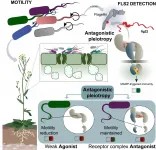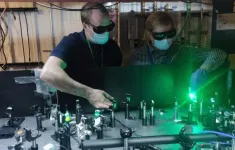Eat me: The cell signal of death
An 'eat-me' signal displayed on cell surfaces requires activation of a lipid-scrambling protein by a nuclear protein fragment
2021-03-26
(Press-News.org) Scientists at the Institute for Integrated Cell-Material Sciences (iCeMS) and colleagues in Japan have revealed molecular mechanisms involved in eliminating unwanted cells in the body. A nuclear protein fragment released into the cytoplasm activates a plasma membrane protein to display a lipid on the cell surface, signalling other cells to get rid of it. The findings were published in the journal Molecular Cell.
"Every day, ten billion cells die and are engulfed by blood cells called phagocytes. If this didn't happen, dead cells would burst, triggering an auto-immune reaction," explains iCeMS biochemist Jun Suzuki, who led the study. "It is important to understand how dead cells are eliminated as part of our body's maintenance."
Scientists already know that dead cells display an 'eat me' signal on their surface that is recognized by phagocytes. During this process, lipids are flipped between the inner and outer parts of the cell membrane via a variety of proteins called scramblases. Suzuki and his team have already identified several of these lipid-scrambling proteins, but some of their activation mechanisms have been unclear.
To solve this, the team used an array of screening approaches to study the scrambling protein called Xkr4. The broad aim was to single out the genes that are active during cell death and to specifically zoom in on Xkr4 and its associated proteins to understand how they interact.
"We found that a nuclear protein fragment activates Xkr4 to display the 'eat me' signal to phagocytes," says iCeMS cell biologist Masahiro Maruoka, the first author of the study.
Specifically, the scientists found that cell death signals lead to a nuclear protein, called XRCC4, getting cut by an enzyme. A fragment of XRCC4 leaves the nucleus, activating Xkr4, which forms a dimer: the linking of identical pieces into configurations. Both XRCC4 binding and dimer formation are necessary for Xkr4 to ultimately transfer lipids on the cell surface to alert phagocytes.
Xkr4 is only one of the scrambling proteins. Others are activated much faster during cell death. The team now wants to understand when and why the Xkr4 pathway is specifically activated. Since it is strongly expressed in the brain, it is likely important for brain function. "We are now studying the elimination of unwanted cells or compartments in the brain to understand this process further," says Maruoka.
INFORMATION:
DOI: 10.1016/j.molcel.2021.02.025
About Kyoto University's Institute for Integrated Cell-Material Sciences (iCeMS):
At iCeMS, our mission is to explore the secrets of life by creating compounds to control cells, and further down the road to create life-inspired materials.
https://www.icems.kyoto-u.ac.jp/
For more information, contact:
I. Mindy Takamiya/Mari Toyama
pe@mail2.adm.kyoto-u.ac.jp
[Attachments] See images for this press release:

ELSE PRESS RELEASES FROM THIS DATE:
2021-03-26
Many tropical cyclone-prone regions of the world are expected to experience storm systems of greater intensity over the coming century, according to a review of research published today in ScienceBrief Review.
Moreover, sea level rise will aggravate coastal flood risk from tropical cyclones and other phenomena, even if the tropical cyclones themselves do not change at all. Models also project an increase in future tropical-cyclone precipitation rates, which could further elevate the risk of flooding.
Researchers at Princeton University, the U.S. National Oceanic and Atmospheric Administration (NOAA), and the University of East Anglia (UEA) examined more than 90 peer-reviewed articles to assess whether human activity is influencing ...
2021-03-26
Scientists have identified new genetic clues in people who've had small and often apparently 'silent' strokes that are difficult to treat and a major cause of vascular dementia, according to research funded by the British Heart Foundation (BHF) and published in The Lancet Neurology.
Researchers discovered changes to 12 genetic regions in the DNA of people who have had a lacunar stroke - a type of stroke caused by weakening of the small blood vessels deep within the brain. Over time, damage to the blood vessels and subsequent interruption to blood flow can lead to long-term disability, causing difficulty with thinking, memory, walking and ultimately ...
2021-03-26
A pediatric heart transplant procedure pioneered by Canadian doctors--once deemed impossible--has been shown to be at least as effective as the traditional approach, according to END ...
2021-03-26
How can we better understand how people move during the pandemic and how they spread COVID-19? New END ...
2021-03-25
From microwave ovens to Wi-Fi connections, the radio waves that permeate the environment are not just signals of energy consumed but are also sources of energy themselves. An international team of researchers, led by Huanyu "Larry" Cheng, Dorothy Quiggle Career Development Professor in the Penn State Department of Engineering Science and Mechanics, has developed a way to harvest energy from radio waves to power wearable devices.
The researchers recently published their method inMaterials Today Physics.
According to Cheng, current energy sources for wearable health-monitoring devices have their place in powering sensor devices, but each has its setbacks. Solar power, for example, can only harvest energy when exposed to the sun. A self-powered triboelectric device can only ...
2021-03-25
BIRMINGHAM, Ala. - Researchers have found an unexpected synergy between a T-cell stimulatory protein -- the ICOS ligand -- and interleukin-10, an immunoregulatory cytokine, to prevent inflammatory bowel disease in mice. The study will aid the understanding of, and future research into, this immune disorder, which includes Crohn's disease and ulcerative colitis. About 1.6 million Americans have inflammatory bowel disease.
Interleukin-10, or IL-10, was already known as a major player to prevent gut inflammation by establishing and maintaining immune homeostasis in the gut, where it is vital for the host to have a peaceful coexistence with normal intestinal microbes, while the immune system still stands ...
2021-03-25
Efforts to shift from petrochemical plastics to renewable and biodegradable plastics have proven tricky -- the production process can require toxic chemicals and is expensive, and the mechanical strength and water stability is often insufficient. But researchers have made a breakthrough, using wood byproducts, that shows promise for producing more durable and sustainable bioplastics.
A study published in Nature Sustainability, co-authored by Yuan Yao, assistant professor of industrial ecology and sustainable systems at Yale School of the Environment (YSE), outlines the process of deconstructing the porous matrix of natural wood into a slurry. The researchers say the resulting material shows ...
2021-03-25
Researchers from the Center for Health, Work & Environment (CHWE) at the Colorado School of Public Health have published a paper in the International Journal of Environmental Research and Public Health studying the effectiveness of applying Total Worker Health (TWH) in an international context. The study, led by a team at CHWE, is the first to examine how a TWH framework operates outside of a western context in Latin America workforces.
"Although recent reviews show that TWH intervention studies have had some global reach, the vast majority have been conducted in Western countries," says lead researcher Diana Jaramillo. "While global organizations, as well as governmental entities in Latin America, acknowledge the importance ...
2021-03-25
Researchers at GMI - Gregor Mendel Institute of Molecular Plant Biology of the Austrian Academy of Sciences, the University of North Carolina at Chapel Hill and The Howard Hughes Medical Institute (HHMI) use two complementary approaches to unveil a co-evolutionary mechanism between bacteria and plants and also explain complex immune response patterns observed in the wild. Together the papers change the way scientists have been thinking about the relationship of a bacterial antigenic component with its plant immune receptor. The two papers are published back to back in the journal Cell Host & Microbe.
Immune responses have developed in virtually all organisms over evolutionary time scales to protect them from foreign ...
2021-03-25
LOS ALAMOS, N.M., March 25, 2021--A new class of quantum dots deliver a stable stream of single, spectrally tunable infrared photons under ambient conditions and at room temperature, unlike other single photon emitters. This breakthrough opens a range of practical applications, including quantum communication, quantum metrology, medical imaging and diagnostics, and clandestine labeling.
"The demonstration of high single-photon purity in the infrared has immediate utility in areas such as quantum key distribution for secure communication," said Victor Klimov, lead author of a paper published ...
LAST 30 PRESS RELEASES:
[Press-News.org] Eat me: The cell signal of death
An 'eat-me' signal displayed on cell surfaces requires activation of a lipid-scrambling protein by a nuclear protein fragment






